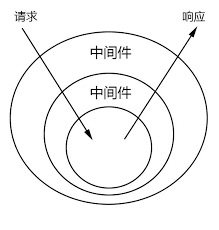手写简版express
简单使用
const express = require('express')
const app = new express()
app.use((req, res, next) => {
console.log('middleware start')
next()
console.log('middleware end')
})
app.get('/', (req, res, next) => {
console.log('home page')
res.send('I am home page.')
})
app.listen(3000)
// 打印
// middleware start
// home page
// middleware end可以看出,express可以被实例化,且包含use/get/listen等方法。而且use/get方法内部存在一定的执行顺序,这个执行顺序符合“洋葱模型”:从外到内再从内到外。

listen方法
首先实现listen方法,express的服务是建立在http模块之上的。因此,可以对http进行一层封装:
const http = require('http')
class Express {
listen(...args) {
const server = http.createServer((req, res) => {
// handle 是发送请求时触发的事件,后续会进行实现
this.handle(req, res)
})
server.listen(...args)
this.server = server
}
}中间件机制
const m1 = (req, res, next) => {
console.log('middleware1 start');
next()
console.log('middleware1 end');
}
const m2 = (req, res, next) => {
console.log('middleware2 start');
next()
console.log('middleware2 end');
}
const m3 = (req, res, next) => {
console.log('middleware3 start');
next()
console.log('middleware3 end');
}以上代码如何才能按照以下顺序执行呢?
// middleware1 start
// middleware2 start
// middleware3 start
// middleware3 end
// middleware2 end
// middleware1 endexpress里是使用一个next方法进行实现的:
const stack = []
stack.push(m1)
stack.push(m2)
stack.push(m3)
function handle(req, res, out) {
let idx = 0
next()
function next() {
if (idx < stack.length) {
const fn = stack[idx]
idx += 1
fn(req, res, next)
} else {
out()
}
}
}
handle({}, {}, () => {
console.log('end')
})
// middleware1 start
// middleware2 start
// middleware3 start
// end
// middleware3 end
// middleware2 end
// middleware1 end整个中间件机制的核心代码只有几行!
Layer类
根据上面的next的代码可以得知,在实现中间件之前,需要维护一个数组,这个数组里的元素包含(req, res, next) => {}。另外由于中间件和请求在执行时,需要匹配路径和方法,所以我们可以定义一个Layer类,用于管理路径匹配和方法执行:
class Layer {
constructor(path, method, handle) {
this.path = path
this.method = method
this.handle = handle
}
// 1. 进行路径匹配
match(path = '/', method) {
// 这里简单匹配一下
// 如果是中间件,path不存在时,符合要求
// 如果是中间件,path存在且匹配时,符合要求
const isMiddleware = !this.path
|| !this.method && path.indexOf(this.path) !== -1
// 如果是请求,path 和 method 均匹配时符合要求
const isRequestMatch = path.indexOf(this.path) !== -1
&& method.toLowerCase() === this.method
return isMiddleware || isRequestMatch
}
// 2. 进行执行方法
handleMethod(req, res, next) {
try {
this.handle(req, res, next)
} catch (err) {
next(err)
}
}
}stack里存放的就是这些layer。在用于发送请求时,只需要遍历stack执行layer.handleMethod方法即可实现中间件的效果。下一步,我们则是定义中间件和请求方法。
get/post等方法
遍历methods,进行方法注册。这样在使用app.get/post/...的时候就会收集相应的回调函数:
class Express {
// 执行函数数组,存放的是 layer
stack = []
constructor() {
this.init()
}
init() {
// 请求方法:get、post等等
const methods = ['get', 'post', 'put', 'delete']
methods.forEach((method) => {
this[method] = (path, callback) => {
const layer = new Layer(path, method, callback)
this.stack.push(layer)
}
})
}
}use方法
use方法与methods类似,也是收集回调函数的过程。这里将传递的参数简单分为了3种形式:
use(middlewares) {
let path = '/'
let fns = []
if (typeof middlewares === 'function') {
// 1. 形式1:app.use(middleware)
fns = [middlewares]
} else if (Array.isArray(middlewares)) {
// 2. 形式2:app.use([middleware])
fns = middlewares
} else {
// 3. app.use(path, [middleware])
path = 形式3:middlewares
fns = Array.isArray(arguments[1]) ? arguments[1] : [arguments[1]]
}
if (!fns || fns.length === 0) {
throw new TypeError('app.use() requires a middleware function')
}
fns.forEach((middleware) => {
const layer = new Layer(path, undefined, middleware)
this.stack.push(layer)
})
}handle 方法
前面通过methods和中间件已经将回调都收集到stack当中了,接下来就是用户请求的时候,去stack中匹配相应路径,然后按中间件的形式执行回调函数。
// 请求时,匹配url,然后找到对应的方法
handle(req, res, out) {
let idx = 0
const stack = this.stack
next()
function next(err) {
// 从 stack 里匹配对应的执行函数
let match = false
let layer = null
while (idx < stack.length) {
layer = stack[idx]
idx += 1
// 这里简单匹配路径
match = layer.match(req.url || '/', req.method)
if (match) break
}
if (!match) {
return out && out()
}
layer.handleMethod(req, res, next)
}
}完整代码
const http = require('http')
class Layer {
constructor(path, method, handle) {
this.path = path
this.method = method
this.handle = handle
}
match(path = '/', method) {
// 这里简单匹配一下
// 如果是中间件,path不存在时,符合要求
// 如果是中间件,path存在且匹配时,符合要求
const isMiddleware = !this.path
|| !this.method && path.indexOf(this.path) !== -1
// 如果是请求,path 和 method 均匹配时符合要求
const isRequestMatch = path.indexOf(this.path) !== -1
&& method.toLowerCase() === this.method
return isMiddleware || isRequestMatch
}
handleMethod(req, res, next) {
try {
this.handle(req, res, next)
} catch (err) {
next(err)
}
}
}
class Express {
// 服务
server = null
// 执行函数队列
stack = []
constructor() {
this.init()
}
init() {
// 请求方法:get、post等等
const methods = ['get', 'post', 'put', 'delete']
methods.forEach((method) => {
this[method] = (path, callback) => {
const layer = new Layer(path, method, callback)
this.stack.push(layer)
}
})
}
use(middlewares) {
let path = '/'
let fns = []
if (typeof middlewares === 'function') {
// 1. app.use(middleware)
fns = [middlewares]
} else if (Array.isArray(middlewares)) {
// 2. app.use([middleware])
fns = middlewares
} else {
// 3. app.use(path, [middleware])
path = middlewares
fns = Array.isArray(arguments[1]) ? arguments[1] : [arguments[1]]
}
if (!fns || fns.length === 0) {
throw new TypeError('app.use() requires a middleware function')
}
fns.forEach((middleware) => {
const layer = new Layer(path, undefined, middleware)
this.stack.push(layer)
})
}
// 请求时,匹配url,然后找到对应的方法
handle(req, res, out) {
let idx = 0
const stack = this.stack
next()
function next(err) {
// 从 stack 里匹配对应的执行函数
let match = false
let layer = null
while (idx < stack.length) {
layer = stack[idx]
idx += 1
// 这里简单匹配路径
match = layer.match(req.url || '/', req.method)
if (match) break
}
if (!match) {
return out && out()
}
layer.handleMethod(req, res, next)
}
}
listen(...args) {
const server = http.createServer((req, res) => {
this.handle(req, res)
})
server.listen(...args)
this.server = server
}
}
module.exports = Express执行结果
const Express = require('./lib/express')
const app = new Express()
const m1 = (req, res, next) => {
console.log('middleware1 start');
next()
console.log('middleware1 end');
}
const m2 = (req, res, next) => {
console.log('middleware2 start');
next()
console.log('middleware2 end');
}
const m3 = (req, res, next) => {
console.log('middleware3 start');
next()
console.log('middleware3 end');
}
app.use(m1)
app.use('/a', m2)
app.use('/b', m3)
app.get('/a', (req, res, next) => {
console.log('page a');
res.end('page a')
})
app.get('/b', (req, res, next) => {
console.log('page b');
res.end('page b')
})
app.listen(3000, () => {
console.log('server is running...')
})
// 访问 /a 时:
// middleware1 start
// middleware2 start
// page a
// middleware2 end
// middleware1 end
// middleware1 start // 这是由于访问 favicon.ico 导致的,可忽略。
// middleware1 end // 这是由于访问 favicon.ico 导致的,可忽略。总结
这里实现的代码比较简单,没有涉及到router的处理,主要是概括了express中间件的实现原理。核心原理大致是:将use和get/post/...等方法注册的回调函数封装成layer形式,并推到stack当中。等用户发送请求时,去stack中依次按照路径和方法名匹配对应的layer。然后按照“洋葱模型”执行匹配到的layer。
